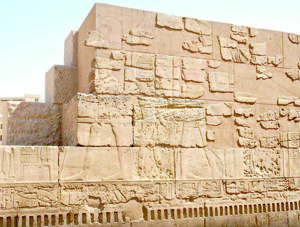The Temple of Luxor is a major attraction in the southern ancient city of Luxor. It is the second largest in the city.
Thanks to its diverse and many ancient sites, Luxor has been functioning as a strong magent for tourists from all parts of the world for centuries now.
The religious beliefs of the ancient Egyptians swayed their urban movements, especially when it came to the construction of temples. They constructed these temples in veneration of their gods.

Nonetheless, the temples are pieces of art, not just centres of faith.
The presence of a huge number of temples in Luxor derives from the political importance of the city in the past. This city used to function as the capital of the New Empire.
The presence of these temples, along with other ancient sites, has contributed to making the city an open-air museum.
The Temple of Luxor comes second in size in the city only to the Temple of Karnak which is located a short distance away.
It is one of the most extraordinary constructions in the city. Dating back to 1392 BCE, this temple was built on the east bank of the Nile River. It is dedicated to the deities, Mut, Khonsu, and Amun.
The construction of the Temple of Luxor was begun by Pharaoh Amenhotep III and was completed by Pharaoh Tutankhamun.
Some constructions were also added to the temple during the reign of Ramses II. Alexander Mango is also known to have renovated the temple and added a chapel of the boat of the god to it.
In 1885, the French Egyptologist Gaston Maspero began excavation work in the area of the temple.
In 1990 one of the most important discoveries was made: 66 new statues of the goddess Leona Sejmet. These statues were transferred to the Museum of Luxor.

The feast of Opet was celebrated at the Temple of Luxor where the god Amon was transferred by a sacred boat from the Temple of Karnak to the Temple of Luxor.
This festivity was in the second and third months of the flood season.
The temple is 260 metres long and 50 metres wide. It is constructed over 10,000 square meters.
At the entrance of the temple, there is a pylon built by Ramses II. There were also two obelisks of Ramses II, but at present, there is one on the left that is 25 metres-high. The other obelisk was moved to France in 1833.
The entrance of the temple is surrounded by six granite giants of Ramses II, sitting on its lathe. The giants are 15.5 metres-high. They stand on a 1 metre-high pedestal.
There is also the court of Ramses II where there are statues of Osiris. The three chapels dedicated to Thebes’ triad (Amon, Mut, and Khonsu) are located in the small temple of Thutmose III.

There is also a colonnade that is 25 metres-high. It leads to the court of Amenophis III. On the outside, there are walls decorated with chapels. Other walls have religious ceremonial scenes on them.
It is believed that the site of the Temple of Luxor was of another temple, dating back to the XIIth Dynasty of the Middle Empire.
The Temple of Luxor is connected to the Temple of Karnak with an avenue of sphinxes with a human heads. This avenue was built by Nectanebo I.
In the Roman period, the Temple of Luxor was a military centre, camp, and later an area of Christian worship.
Luxor can be reached from Cairo by train or by air. It is a beautiful city that boasts a large number of tourist facilities, including hotels that suit all types of budgets. The people of the city are also so friendly.






Discussion about this post